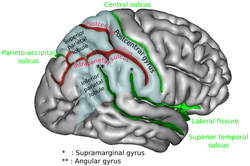| Intraparietal sulcus | |
|---|---|
 Lateral surface of left cerebral hemisphere, viewed from the side. (Intraparietal sulcus visible at upper right, running horizontally.) | |
 Right cerebral hemisphere, viewed from the side. The region colored in blue is parietal lobe of the human brain. Intraparietal sulcus runs horizontally at the middle of the parietal lobe. | |
| Details | |
| Part of | Parietal lobe |
| Identifiers | |
| Latin | sulcus intraparietalis |
| Acronym(s) | IPS |
| NeuroNames | 97 |
| NeuroLex ID | birnlex_4031 |
| TA98 | A14.1.09.127 |
| TA2 | 5475 |
| FMA | 83772 |
| Anatomical terms of neuroanatomy | |
The intraparietal sulcus (IPS) is located on the lateral surface of the parietal lobe, and consists of an oblique and a horizontal portion. The IPS contains a series of functionally distinct subregions that have been intensively investigated using both single cell neurophysiology in primates[1][2] and human functional neuroimaging.[3] Its principal functions are related to perceptual-motor coordination (e.g., directing eye movements and reaching) and visual attention, which allows for visually-guided pointing, grasping, and object manipulation that can produce a desired effect.
The IPS is also thought to play a role in other functions, including processing symbolic numerical information,[4] visuospatial working memory,[5] decision-making,[6] and interpreting the intent of others.[7][unreliable medical source?]
- ^ Colby C.E.; Goldberg M.E. (1999). "Space and attention in parietal cortex". Annual Review of Neuroscience. 22: 319–349. doi:10.1146/annurev.neuro.22.1.319. PMID 10202542.
- ^ Andersen R.A. (1989). "Visual and eye movement functions of the posterior parietal cortex" (PDF). Annual Review of Neuroscience. 12: 377–403. doi:10.1146/annurev.ne.12.030189.002113. PMID 2648954.
- ^ Culham, J.C.; Nancy G. Kanwisher (April 2001). "Neuroimaging of cognitive functions in human parietal cortex". Current Opinion in Neurobiology. 11 (2): 157–163. doi:10.1016/S0959-4388(00)00191-4. PMID 11301234. S2CID 13907037.
- ^ Cantlon J, Brannon E, Carter E, Pelphrey K (2006). "Functional imaging of numerical processing in adults and 4-y-old children". PLOS Biol. 4 (5): e125. doi:10.1371/journal.pbio.0040125. PMC 1431577. PMID 16594732.
- ^ Todd JJ, Marois R (2004). "Capacity limit of visual short-term memory in human posterior parietal cortex". Nature. 428 (6984): 751–754. Bibcode:2004Natur.428..751T. doi:10.1038/nature02466. PMID 15085133. S2CID 4415712.
- ^ Valdebenito-Oyarzo, Gabriela; Martínez-Molina, María Paz; Soto-Icaza, Patricia; Zamorano, Francisco; Figueroa-Vargas, Alejandra; Larraín-Valenzuela, Josefina; Stecher, Ximena; Salinas, César; Bastin, Julien; Valero-Cabré, Antoni; Polania, Rafael; Billeke, Pablo (10 January 2024). "The parietal cortex has a causal role in ambiguity computations in humans". PLOS Biology. 22 (1): e3002452. doi:10.1371/journal.pbio.3002452. PMC 10824459. PMID 38198502.
- ^ Grafton, Hamilton (2006). "Dartmouth Study Finds How The Brain Interprets The Intent Of Others". Science Daily.